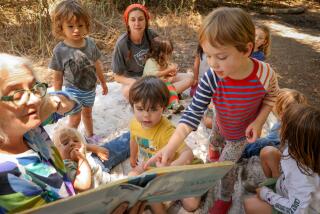Staying Afloat : Youths Learn Survival Skills at Timber Camp
- Share via
FIRE COVE LOGGING CAMP, Alaska — The three Rs are just kid stuff to the youngsters at this floating timber camp. They must pass a tough swimming test--200 yards to shore and back in frigid waters--before they can walk around without life jackets.
Survival skills and learning to cope with the environment come early to the 19 students who tread the wooden sidewalks at this temporary community, anchored off Revillagigedo Island, about 30 miles north of Ketchikan.
The students who reside at timber camps like Fire Cove are part of a logging tradition that brought their parents and their parents’ parents to the woods and waters of southeastern Alaska.
There are 489 students in the 20,000-square mile Southeast Island School District, which stretches from Dixon Entrance to the Frederick Sound. Of that number, 399 students attend classes in the district’s 16 school buildings, and 90 are in correspondence study.
Eleven of the schools are in logging or fishing camps, and the rest are in permanent locations. Most of the communities are accessible only by float plane or boat.
Programs More Irregular
District Supt. Bob Weinstein said the programs are a bit more irregular than those offered in urban areas.
In addition to the camp teachers, the staff includes three music teachers, two special education teachers, a language specialist, a kindergarten specialist, a librarian, a correspondence study teacher and a nurse. All regularly fly the logging camp circuit to provide their special kinds of expertise.
Most of the persons living in the logging camps live in mobile homes because much of the area is federal forest land where no permanent dwellings are allowed.
The Fire Cove operation includes 20 families and about 20 workers assigned to bunk houses during the height of the logging season.
The community has 24 mobile homes, four regular houses, a gym, multigrade school and playground. All sit on decking lashed to huge logs that float the entire village on the water.
Husband-Wife Team
Don and Biz Robbins teach grades one through nine at the camp school. Their trailer is parked a few yards from the gym and classroom. The camp playground, which consists of a few swings and a small merry-go-round, is in their front yard.
“The job is total immersion, 24 hours a day,” said Robbins, 49, who came to Alaska from Colorado Springs, Colo. “I’d rather have the playground farther removed from the trailer, but that’s not a problem. It’s kind of nice. If the kids have a question, we’re right there.”
Robbins said the job requires some skills not needed at most schools--like fixing the furnace.
“But you’ve always got the community to fall back on if you’ve got a mechanical problem,” he said. “Everyone is willing to pitch in.”
The Fire Cove kids are a little more inventive and motivated than others he has taught, Robbins said. “I think there’s an awful lot of push from the parents that their kids get more education than they got,” he said.
Life Vests Required
Camp owner Roger Gildersleeve, whose policy requires children to wear life vests whenever they venture outside--until they prove they know how to swim--said the school’s isolation does not seem to have affected its quality.
“This school has put out its share of kids with scholarships,” Gildersleeve said. “We think it’s a pretty good school.
More to Read
Sign up for The Wild
We’ll help you find the best places to hike, bike and run, as well as the perfect silent spots for meditation and yoga.
You may occasionally receive promotional content from the Los Angeles Times.






